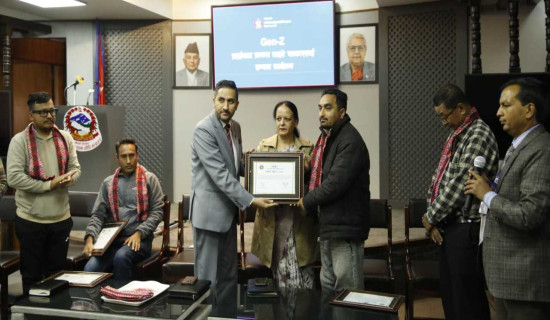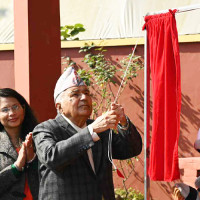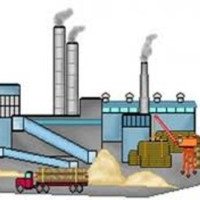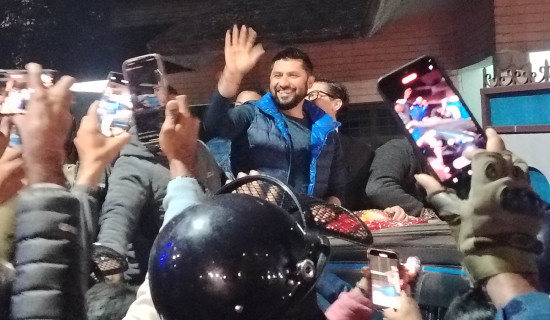- Saturday, 20 December 2025
Modern Day Slavery Why Does It Exist?
Prabalta Rijal
Modern day slavery in its various forms is considered illegal, prohibited by international laws and is the same in over 121 countries around the world. But it still thrives because of three main factors and the intertwining relationship between them: 1. Individual vulnerability and marginalization 2. Industrialization and demand for very cheap labour 3. Weak laws and governance
Poverty
Throughout history poverty has always been the reason behind individual vulnerability be it in the 19th century when slaves were used to farm sugar in the Americas or today where over 90 percent of the slaves belong to countries from the developing world and 58 percent of them come from five Asian countries: India, China, Pakistan, Bangladesh and Uzbekistan.
All of these countries have high levels of poverty and where there is poverty and the lack of economic opportunities; people take risks in their desire for a better life. As the global population booms the ratio between jobs and number of people increases so there are less jobs and more people. Leading to unemployment and poverty.
Poverty led vulnerability is the main reason why so many women and children are falling prey to human trafficking in countries across the world. According to Adrián Begáň, head of the National Unit for the Fight against Illegal Migration of the Police Corps’ Presidium, in Slovakia traffickers pay anywhere between €3,500 to €20,000 per person, depending on their age, where they come from, and what kind of work they are into.
Marginalised Groups
Marginalised groups across the world - be it the aborigines in Australia or the Dalits in South Asia — have mostly lived in poverty all their lives. Such groups are always vulnerable as they have no resources for survival, or easy access to basic rights like education, health care and justice, so they are therefore forced to live their whole lives as slaves.
For example, the Dalit community in India even today work as bonded labour in brick kilns in South India, according to reports by The Liverpool National Museum, every year after the rice harvesting season, over 200,000 people migrate from Odisha to brick factories in Andra Pradesh, as they are unable to pay off loans as little as INR 12,000 (145.62 Euros).
They live in shanty huts with no proper sanitary facilities like toilets or clean drinking water and women and children are usually physically abused and exploited in such places.
Similarly, a recent report by Aljazeera claimed that a lot of migrant workers from lower castes in Nepal are moving to the middle east to get away from the haruwa-charuwa system in the country.
According to data published by the National Crime Agency in 2014, child’s slaves came mainly from South East Asia, Africa, Eastern Europe. And we aren’t talking about the rule of law or governance in a poor country we are talking about a country which prides its governance.
The Haruwa-Charuwa system is a type of bonded labor system that is still practiced in the terai regions of the country. However, despite escaping to countries like Saudi Arabia, these people still fall prey to unfair labor practices. “The pay was better, accommodation and meals were provided, but I still worked for a rich person at the end of the day. There is no one to listen to us and our problems, to be compassionate.
Being a poor man will always be hard, be it in Nepal or Saudi Arabia,” Rajkumar Mahato, a gulf returnee turned activist, told Aljazeera. According to him fleeing to the gulf is not really the best solution as even to get there, these workers are forced to pay manpower brokers excruciatingly high fees.
Some workers have claimed to have paid as much as 100,000 Nepali Rupees that is approximately 757 Euros in illegal fees only to find that they do not even receive the promised salary amount. Although the government of Nepal has capped manpower fees to just 12,000 Nepali rupees.
A report published in April 2022, by the Business &Human Rights Resource center found that approximately 10 Nepali workers that were recruited for a construction company in Saudi Arabia had been forced to pay approximately 1,200-1,660 Euros but did not get the job that they paid for and were stranded in Saudi Arabia without a job. Despite laws, the practice of extorting high fees for recruitment is still very much common and an under the table practice that is continually ignored.
Political Unrest and Migration
Similarly, people from marginalized groups in countries where there is civil unrest tend to suffer from abject poverty and are most affected by modern day slavery. They have no resources to protect themselves from slavery and their need for survival forces them into the trade. This is also true for asylum seekers and people who have been left stateless due to the wars in their countries, towns and villages.
According to reports, Syrian refugees in Lebanon and other countries have become subjects to slavery. Child labor is rampant, sex for survival is term now being used commonly as many women are forced to sleep with human smugglers in an effort to get to get on to a boat to Europe, as the conditions in these camps worsen. The same applies to the Muslim Rohingya population who are being systematically killed and forced to leave their homes by the government of Myanmar, and for any other refugee seeking asylum.
Demand For Cheap Labour
The way slavery is viewed is flawed. Let us not forget it is not a desperate mother who sells her body to feed her child who is wrong, it is the society that forces her into prostitution that is wrong. The Industrialized and capitalistic world we live in today, has been architectured by the Western world.
For centuries the western world has thrived on goods produced from very cheap labour, as they are unwilling to pay the true price of labour. The history of the slave trade was rampant during the era of industrialization in Europe. Industries thrived on slave cotton from the US, sugar grown by slaves in Latin America and tea from plantations in India. This tendency for cheap stuff is still prevalent.
This is why brands like Benetton, JC Penney, Mango are still in business, even after the collapse of the Rana Palace in Bangladesh in 2013, where 1,134 workers lost their lives in the disaster, while working in sweatshops that produced clothes for these clothing brands. Although the garment business is the economic bloodline of this South Asian nation is it really fair that workers are treated this way?
What about the chocolates we love so much? Ehere do they come from? Chocolate companies like Mars, Nestle and Hersheys have long been flagged for aiding slavery in cocoa plantations in Western Africa.
Over 70 per cent of the cocoa produced in the world comes from South Western Africa , where children are forced to drop out of school and work on family run plantations to support their families or are or are sold to traffickers who in turn sell them to large cocoa farm owners who force them to work in farms for no pay at all. Forced labor is the most common form of modern-day slavery and this usually affects the vulnerable and excluded groups, even in developed countries.
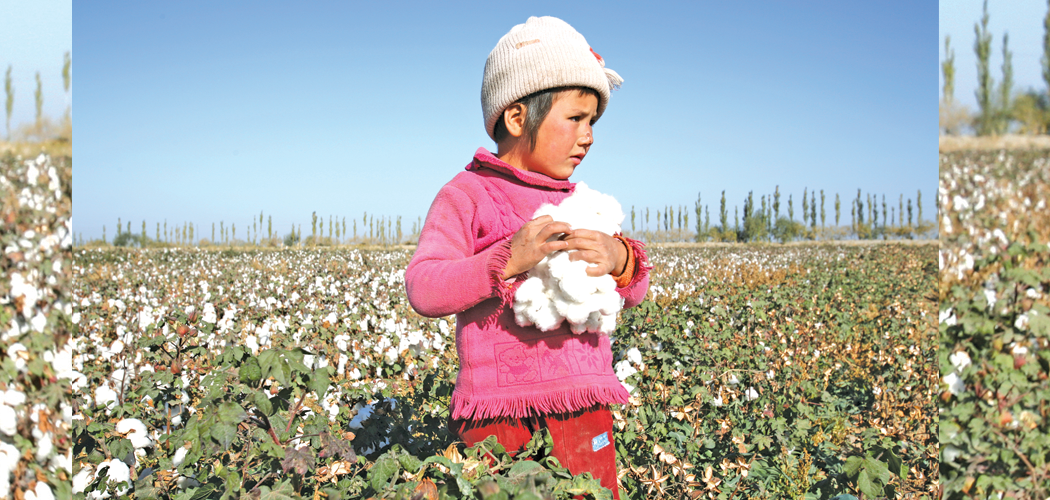
Weak Laws And Governance
Today because of the weak rule of law in the developed and developing world, thousands of people are forced into slavery. When the people who have been sworn into office don’t take their responsibilities seriously, it’s only natural that the illegal entities find loopholes in the system.
It’s really funny that getting a visa to the UK even for tourism purposes is very, very difficult for people of African and Asian descent, but sadly traffickers and smugglers walk in and out of the borders, without getting caught and without anyone questioning them what their relationship with the child they are travelling with is, no one bothers to ask these children who they are. How are these people getting past border control, in a country with very strict immigration laws?
According to data published by the National Crime Agency in 2014, child’s slaves came mainly from South East Asia, Africa, Eastern Europe. And we aren’t talking about the rule of law or governance in a poor country we are talking about a country which prides its governance. NCA’s report in 2017 stated that Modern Day slavery is much more widespread and rampant than what the law enforcement previously thought. So, although the bill for the Modern Slavery Act was passed years ago, the battle against slavery isn’t over.
Anti-ImmigrationLaws
In fact Asylum seekers coming to European countries like the UK today, are extremely vulnerable to modern day slavery due to immigration laws that fail to protect and integrate them into society. They have to wait for years to get their asylum claim accepted and majority of the times they aren’t so lucky.
So, once their claim gets rejected they have nowhere to go and continue to stay illegally in the countries they entered. And to make matters worse for them, host countries like the UK keep making ludicrous asylum laws, like the one to divert all asylum seekers to Rwanda. Which happens to be one of the world’s poorest country, that is still recovering from its own internal conflict.
Conflicts
People living in places of conflict like the Iraq, Syria and Central Africa are especially prone to modern day slavery, because of poor governance. A very good example would be the abduction of 200 girls by the terror organization Boko Haram back in 2014, which used most of them as sex slaves. How could 200 children be abducted in broad daylight?
We have child soldiers fighting on both the rebel and government side in these places to extract conflict minerals — (Tin, tantalum, Tungsten and gold), which go into our circuit boards to create our smart devices.
Tantalum is the best known conductor of electricity and it’s used in capacitors that keep our smart devices running. According to an article published by dissentmagazine.org, approximately a quarter of the world’s tantalum comes from the war ridden areas of the Democratic Republic of Congo and it is extracted both legally and illegally by children who dig it out of the ground with picks, shovels, and even their bare hands. “The war economy has set the standard for working conditions in mines throughout the DRC. Children as young as six years old still make up an estimated 40 percent of the mining workforce,” the article stated.
Failures
The fact that Slavery exists at such a high scale is proof of failure by governments worldwide at implementing laws and adopting norms, which prevent slavery and extreme exploitation of the world’s most vulnerable people. It thrives because of bad governance and rampant systematic corruption.
If this wasn’t the case our borders wouldn’t be porous to traffickers, nor would there be thousands of forced labourers working in factories in South Asia and Europe, nor would there be red light districts in big cities of countries like India and in other parts of the world where children are openly working as sex slaves.
The war against slavery was long fought and apparently won, but even today modern day slavery is rampant in our societies and fighting it has become a daunting task because it means confronting the long established and powerful economic models, corruption, discrimination, and abusive power holders.
(Prabalta is an author, journalist, technophile, and blogger with over 15 years of experience in the media industry)



